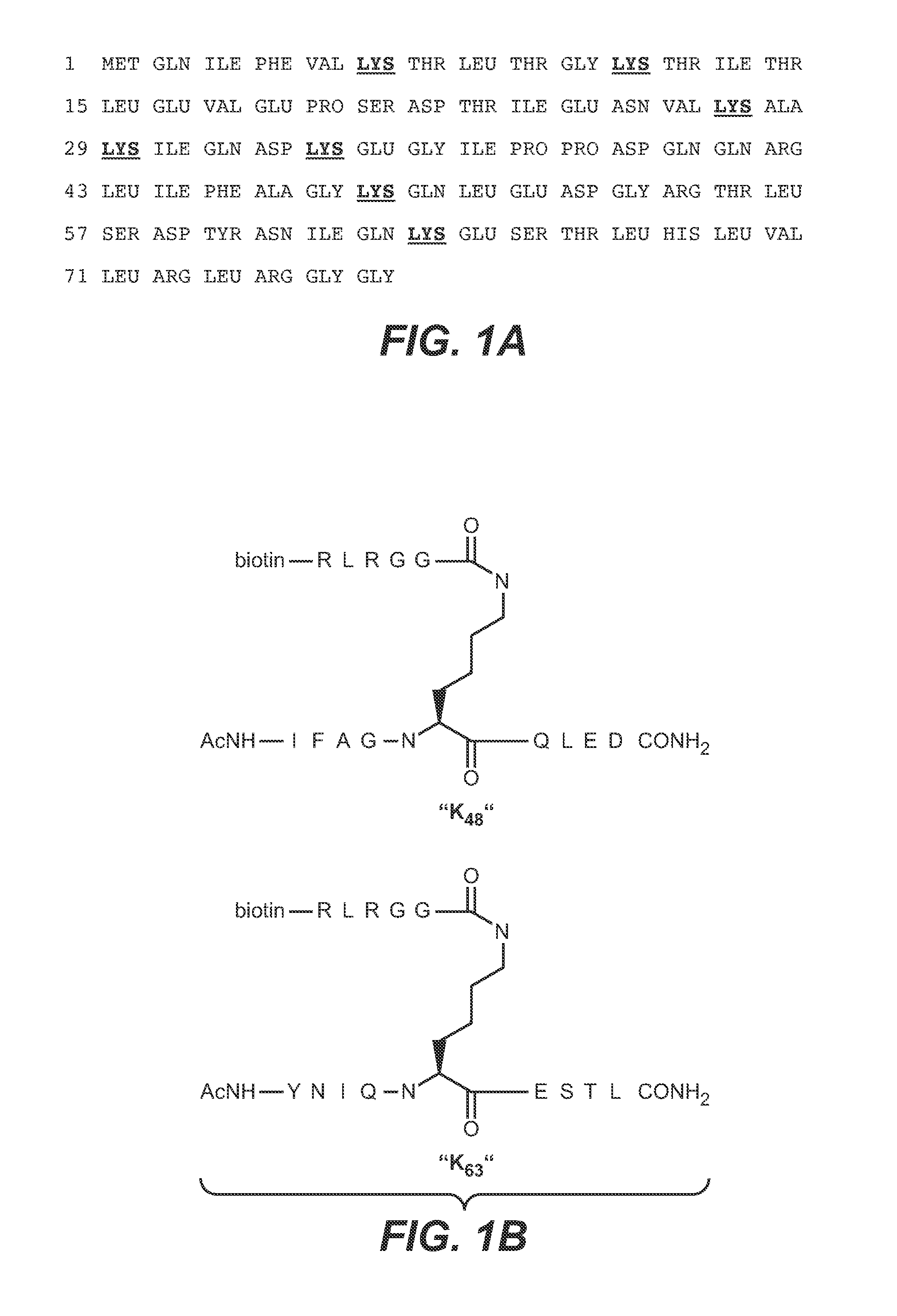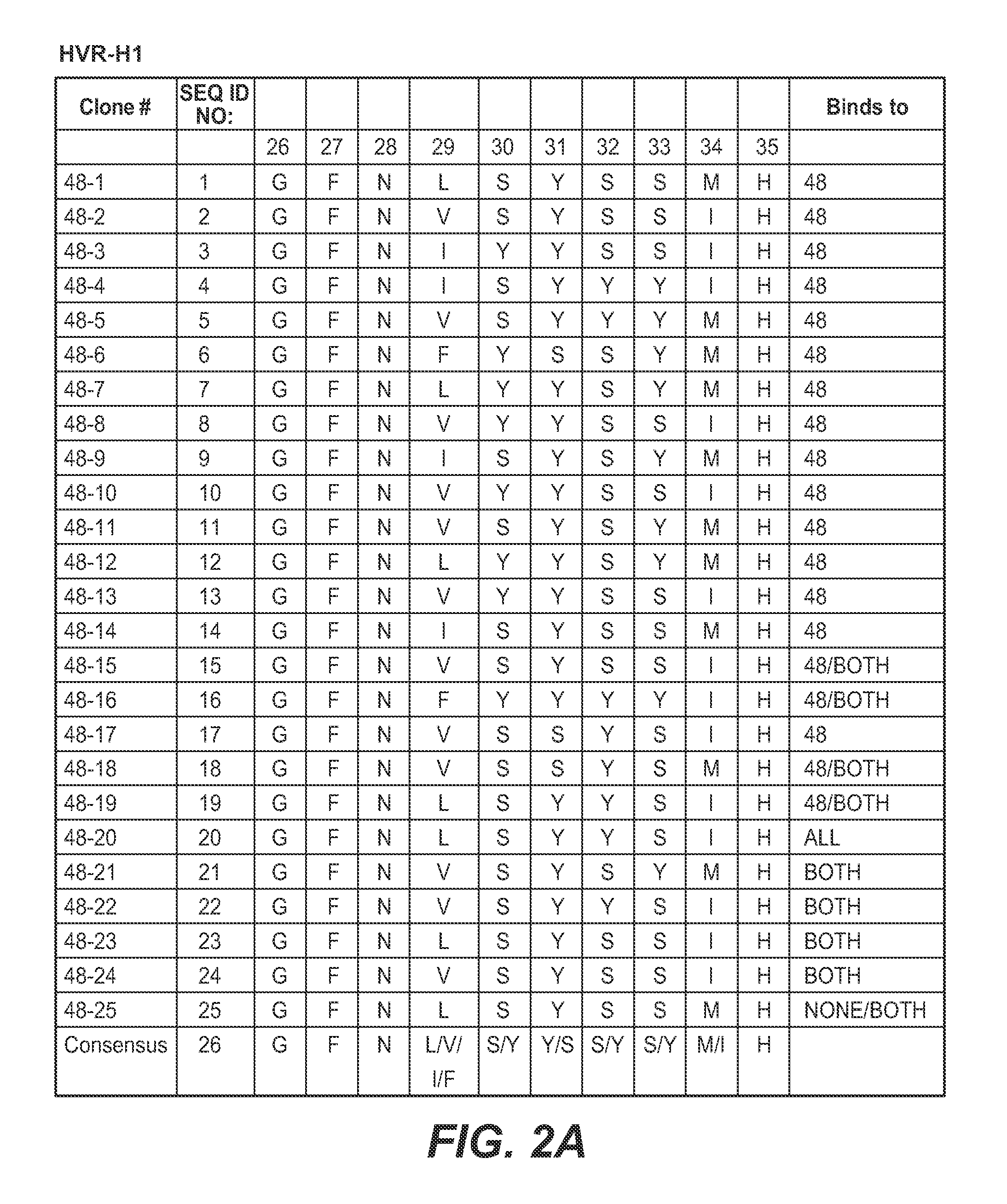Methods and compositions for targeting polyubiquitin
a polyubiquitin and polyubiquitin technology, applied in the field of antipolyubiquitin antibodies, can solve the problems of affecting the normal physiological behavior of the lysine-linked polyubiquitin, affecting the normal cellular proteolytic processing system, and each of the methodologies is ill-suited or cumbersome for analysis of normal physiological behavior,
- Summary
- Abstract
- Description
- Claims
- Application Information
AI Technical Summary
Benefits of technology
Problems solved by technology
Method used
Image
Examples
example 1
Isolation and Characterization of First Generation Anti-Polyubiquitin Antibodies
[0377] A) Library Sorting
[0378] Phage from naïve antibody libraries were subjected to binding selection against immobilized synthetic peptides including an isopeptide bond mimicking either K48-linked polyubiquitin or K63-linked polyubiquitin. No enrichment was observed after six rounds of selection. The synthetic peptides were lengthened, and the naïve antibody libraries were again screened. Once again, no enrichment was observed after six rounds of binding selection.
[0379] Phage from the naive YS-B antibody library were subjected to four rounds of binding selection against polyubiquitin chains having different known ubiquitin isopeptide linkages. The YS-B antibody library contains randomized amino acids in all three heavy chain CDRs and light chain CDR3 (see U.S. Published Patent Application No. 2005-0106667), and is based on humanized antibody 4D5.
[0380] Enzymatically synthesized full-length K48-li...
example 2
Isolation and Characterization of Second Generation Anti-Polyubiquitin Antibodies
[0395] Second generation libraries for Fab display were constructed from the phagemids encoding the previously identified clones apu05 (K48-linked polyubiquitin-selective) and apu 18 (K63-linked polyubiquitin-selective) (see FIGS. 10 and 11). Phage from those clones were used to infect CJ236 cells to prepare Kunkel DNA templates. Those templates were subsequently mutagenized to insert stop codons, and the stop-containing templates were used in library construction as follows.
[0396] The Fab apu05 was mutagenized according to two different schemes to create two different apu05-derived libraries. In the first library, only HVR-H3 was mutagenized. HVR-H3 was first modified to include a stop codon in the Kunkel template, followed by a mutagenesis utilizing four mutagenic oligonucleotides. The stop codon-encoding oligonucleotide in all cases was CGTCTATTATTGTGCTCGCTAATAAGACTACTGGGGTCAAGG (SEQ ID NO: 365). T...
example 3
Binding of Anti-Polyubiquitin Antibodies to Endogenously Polyubiquitinated Proteins
[0414] Previous experiments had demonstrated that the activity of Receptor Interacting Protein (RIP), a 140 kD essential mediator of the proximal TNF receptor 1 (TNFR1) signaling complex, is modulated by polyubiquitination (Wertz et al., Nature 430: 694-699 (2004)). When RIP is polyubiquitinated with K63-linked polyubiquitin chains, signaling through TNFR1 is facilitated. Removal of the K63-linked polyubiquitin chains from RIP by the de-ubiquitinating N-terminus of A20 and replacement with K48-linked polyubiquitin chains by the ubiquitin ligase function of the A20 C terminus inactivates RIP and targets it for proteasomal degradation. That mechanism had been elucidated using cell lines expressing mutant ubiquitin capable of forming only K48-linked or K63-linked polyubiquitin.
[0415] The ability of two of the anti-K48 and anti-K63-linked polyubiquitin binding proteins of the invention to specifically r...
PUM
| Property | Measurement | Unit |
|---|---|---|
| binding affinity | aaaaa | aaaaa |
| nucleic acid | aaaaa | aaaaa |
Abstract
Description
Claims
Application Information
 Login to View More
Login to View More - R&D
- Intellectual Property
- Life Sciences
- Materials
- Tech Scout
- Unparalleled Data Quality
- Higher Quality Content
- 60% Fewer Hallucinations
Browse by: Latest US Patents, China's latest patents, Technical Efficacy Thesaurus, Application Domain, Technology Topic, Popular Technical Reports.
© 2025 PatSnap. All rights reserved.Legal|Privacy policy|Modern Slavery Act Transparency Statement|Sitemap|About US| Contact US: help@patsnap.com



